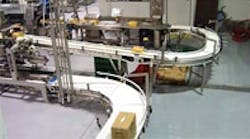Material handling dilemmas and tight floor space are common concerns among food and beverage producers everywhere. Odom's Tennessee Pride, Madison, Tenn. — one of the largest private sausage makers in the country — is no exception. The company recently faced such a problem at its high capacity plant in Dickson, Tenn. Odom's needed help with a number of issues.
First, due to limited floor space on the plant's ground level, carton and case flats must be stocked and erected on the second floor. A method was needed to transport the boxes and cartons — with the lids up — from the second floor to the ground floor. However, floor space limitations also meant that the product handling equipment needed to have a very small footprint, since the available ground floor space was required for manual assembly of biscuit sandwiches, as well as wrappers, cartoners, casepackers, and palletizers. Another concern was keeping noise levels to a minimum.
The company wanted to work with a single conveyor supplier and chose SpanTech LLC, Glasgow, Ky. The initial plant design called for five lines, but Odom's sales increased so dramatically during the engineering phase that two additional lines had to be added, with each line capable of producing 800 sausage sandwiches per minute. Once the application dynamics, product information and specifications, and floor layouts were given to SpanTech, conveyor design and engineering began. Carton and case flats were subjected to decline testing, using a WG-Series wedge conveyor in SpanTech's R&D area. A video of the testing was provided to Odom's engineers, who then gave SpanTech a CAD drawing that showed exact machine placement.
Conveyors were installed at the discharge area of each carton and case erector on the upper level, to transport cartons and cases to the wedge conveyor for decline to the floor level. One wedge unit declines cartons to the cartoner, while a second unit declines cases to the case packer. Individually wrapped products are conveyed from the wrapper discharge to the cartoner, and then the cartons are filled and transported to the case packer. Finally, filled cases are transported to robotic palletizers. For more information, visit www.spantechllc.com
